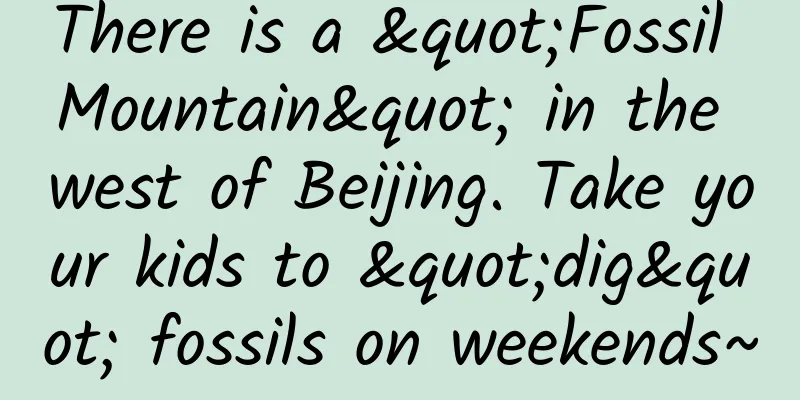There is a "Fossil Mountain" in the west of Beijing. Take your kids to "dig" fossils on weekends~

|
Reviewer: Ma Zhifei Geological science writer, senior engineer Mentougou District is located in the Western Hills of Beijing. It has deep and long canyons, winding rivers, rocky underground caves, green alpine meadows, and mysterious messengers from the ancient world - paleontological fossils. In the billions of years of life evolution on Earth, countless creatures have come and gone, experiencing peaks and ends in a long time. Fossils allow us to glimpse the wilderness of life on Earth billions of years ago. When you hammer open a fossil, you open up a dusty past. On weekends, become a "wild explorer" and explore the mysteries of prehistoric life! How to find fossils? The destination of our trip is Huiyu Village, Junzhuang Town, Mentougou District, where there is a "Fossil Mountain". There are so many rocks in the wild, how can we determine which rocks contain fossils? First, let's learn about rocks. The types of rocks on Earth are divided into three categories: igneous rocks, sedimentary rocks, and metamorphic rocks, but fossils can only be found in sedimentary rocks. The formation of sedimentary rocks is a long process, with a large amount of debris accumulated in depressions or basins. After a long period of compaction, it consolidates into hard rocks. Schematic diagram of the formation process of sedimentary rocks Source: Sohu How to identify sedimentary rocks in the wild? The simplest way is to see whether the rocks are "layered" because sedimentary rocks are formed by stacking up layer by layer, just like making a thousand-layer pancake. Therefore, sedimentary rocks have a typical stratification structure, and the age of the rocks is "old at the bottom and new at the top". If the sedimentary environment is relatively stable when the rocks are formed, and there is no compression and damage in the later period, then the rock layers are generally horizontal, and we can clearly see the lamination of the rocks. It is obvious that sedimentary rocks are the source of stratification | Ma Zhifei Common sedimentary rock types include conglomerate, sandstone, siltstone, shale, limestone, etc. The fossils in Mentougou are mainly "hidden" in sandstone, siltstone and shale, which were formed in the Carboniferous-Permian period about 200 to 300 million years ago. Shale has thin lamellae or thin lamellae, and is generally gray-black in color and has a low hardness; sandstone is divided into coarse sandstone, medium sandstone, fine sandstone, etc. according to the size of the debris; the size of the debris of siltstone is very small, mainly between 0.0625-0.0039mm. Generally speaking, the finer the sediment, the more conducive it is to the preservation of fossils. Source: People's Education Press High School Geography Textbook Fossils are formed when the remains of organisms, traces of life activities, and organic molecules of biological origin in the geological history are preserved in the rock strata. Fossils record the information of ancient organisms and are our "time machine" to look back to the past. From the lifelike fossils, we can see the footprints of dinosaurs, the feathers of birds, the teeth of fish, and the veins of leaves. Why are they still well preserved after millions or even hundreds of millions of years? Source of Archaeopteryx fossils|Hui Junbo We know that after animals and plants die, if they come into contact with air, their soft tissues will be quickly decomposed by microorganisms; while hard parts such as bones, teeth, and wood fibers are more easily preserved. However, if they experience long-term weathering and erosion, the hard parts will gradually disappear. So, what conditions are needed for the formation of fossils? After a creature dies, it must be buried quickly and not washed out of the ground. If the remains of a creature fall into a river, lake, or swamp, and are covered by the surrounding sediments and buried under the water, instantly isolating it from the air, the chance of forming a fossil increases. As mentioned earlier, sediments are constantly compacted and solidified into rock. When the pressure is too great, the shape of the remains of the creature will be deformed. Therefore, only when the compaction and recrystallization are small can the remains of the creature form a complete fossil. Fossil formation process source|NDstudies.gov The formation of fossils must involve fossilization. Fossilization refers to the process by which the remains, relics and remains of ancient organisms become as hard as stone through physical and chemical reactions. Today we will introduce the three main types of fossilization: 1. Mineral filling. Some hard parts of organisms, such as bones, are relatively loose and porous. The pores are filled with minerals, making the hard parts dense, solid, and heavy, thus forming skeletonization. 2. Replacement. Minerals in rocks penetrate into the remains of organisms and exchange with the constituent substances of the organisms. After a long time, the components of the organisms are replaced by minerals to form fossils, while the internal structure remains unchanged. A typical example is petrified wood, where the carbon element in the tree is replaced by silicon, calcium and other elements, while the shape of the trunk remains the same, and even the annual rings are clearly visible. Source of petrified wood | Ma Zhifei 3. Carbonization. During the formation of rocks, the temperature and pressure will increase, causing the organisms to be decomposed and distilled, and the volatile nitrogen, hydrogen, and oxygen elements to escape, leaving only the more stable carbon film to remain and become fossils. After many changes, the bones of animals, leaves of plants, etc. merged with the rocks and turned into hard fossils. Later, under the influence of crustal movement, the strata containing fossils were lifted to the surface and eroded by external forces, thus being exposed and discovered by us. The skill of digging fossils has finally reached the hands-on stage that people are looking forward to. How can you knock out a fossil perfectly? "If you want to do your job well, you must first sharpen your tools." First of all, you need a set of equipment-geological hammer, splitter, brush, and gloves. After finding the stratigraphic section, peel off the rock layer from top to bottom. What we need is shale rock layer. After taking out the rock, observe it and first see if there are fossils on the cross section. If there are, try to avoid destroying it; on the longitudinal section, the rock is layered, with some cracks or gaps distributed on it, which is the bedding. Along the bedding, the rock is easiest to be knocked open, and the possibility of containing fossils is also greater. Then put the rock on the ground, it is best to fix it, and stick the tip of the splitter in the bedding, and then use the geological hammer to hit the other end of the splitter, so that the stone slab is split open. Source: A shopping website A slate can often be split into several layers. Each time you split a layer, pay attention to whether there are fossils on the exposed surface. Sometimes there are multiple fossils in a slate. After the fossils are exposed, you can use a brush to gently sweep away the dust and then store them in a storage box. You can also learn how to repair fossils later. Everyone should remember not to knock them randomly, which will not only waste effort but also damage the integrity of the fossils. Get to know these typical fossils. The strata of Shiyu Village contain a large number of terrestrial plant fossils, such as Lepidocarpus, Pteridophyte, Pteridophyte, Verticillaster, Corda, etc. Finally, let's get to know these amazing fossils. • Lepidodendron: A genus of the order Lepidodendrons in the class Lycopodii. It has scaly bark and rhombus-shaped leaf seats on the surface of the trunk. The leaf scars (the part where the leaf is attached to the stem) are transverse rhombus, oblique square, etc., and are relatively uniform in size. Source: Earth Science Dictionary Source: Baidu Encyclopedia • Ferns: They belong to the order Macropterygii of the order Pteridophyta, and their branches and leaves are arranged like feathers, and their leaves are fern-shaped. According to the differences in the morphological types of fern leaves, they are divided into comb ferns, wedge ferns, fan ferns, and vein ferns. Source: "The Macrofossil Record of True Ferns in the Mesozoic Era of China" Source: Baidu Encyclopedia • Whorled leaves: It belongs to the genus Whorled leaves of the order Equisetales, class Sphenopsida, and is a fossil leaf of the sphenopsida. The branches and leaves are symmetrical on both sides, and the leaves are arranged in whorls. The leaves are radially arranged at the nodes of the last branch or the last second branch. Oriental whorled leaves are commonly seen in Huiyu Village, with about 16 to 20 leaves in each whorl, and the leaves are of relatively uniform length. Annularia vertebrata Source: "The First Discovery of Carboniferous Lycopodium Fossils in Beijing", Yin Jicai and Lü Linsu Origin of living horsetail plants丨Baidu Encyclopedia • Arundophyllum: It is a plant of the genus Arundophyllum, order Equisetales, class Sphenopsaeformis. The plant body is a tree 10 to 30 meters tall, with a distinctly segmented trunk, and the internodes are covered with longitudinal, parallel lines. The branches and leaves grow in a whorl, and the underground stems grow horizontally. The wheel blade and reed wood restoration image source: Wikipedia The origin of the lines on the tree trunk丨Earth Science Dictionary • Corda: It is a plant of the genus Corda, class Cordaclass. It was most prosperous in the Carboniferous and Permian periods. Most of them are tall and slender trees, generally 15 to 30 meters high. Its leaves are huge, with a single leaf up to 1 meter long and nearly 20 cm wide, with many parallel veins on the surface. Source: Earth Science Dictionary Source: Wikipedia Today’s “Treasure Hunt Adventure” is coming to an end. I hope you have the opportunity to personally mine fossils that are about 300 million years old to unlock the code of life in the ancient world. Collecting a fossil means collecting an unforgettable time travel. |
<<: Today, I sent you 6 tons of express delivery
>>: After years of hard study, don’t go to a fake university!
Recommend
Marshall Kilburn II portable speaker: rocking the rock blood with a retro and unruly attitude
Since its birth in 1962, Marshall audio has becom...
Can I receive express delivery in Hangzhou now? Can I receive express delivery passing through Hangzhou?
A few days ago, several couriers at SF Express tr...
How to optimize Google search ad keywords?
I believe everyone knows the importance of Google...
Already in place! The Long March 2F rocket and the Shenzhou XIV spacecraft have been transferred to the launch area, waiting for the astronauts to fly!
On the morning of May 29, the Shenzhou XIV manned...
Lao Hu's "Taoke Special Training Camp 3rd Period" course video Baidu Cloud download
Lao Hu's "Taoke Special Training Camp Th...
Online operation and promotion strategy!
After 2020, affected by the epidemic, offline yog...
One-click information capture, is the high-dimensional light field detector so powerful?
Produced by: Science Popularization China Author:...
The O2O showdown between Dianping and Meituan: Platform vs. self-operated
Dianping and Meituan, which started out as mercha...
Taking a census of galaxies? China's sky survey helps resolve the Hubble crisis!
The English version of Science China Physics, Mec...
Is the bone paste in starch sausage really terrible? Can we still eat starch sausage?
During the 315 period this year, starch sausages ...
Advertising Cases | Traditional lending and driving test industry advertising cases and data references!
Today, I would like to share with you some invest...
User purchasing behavior path analysis
Some time ago, I started to develop the habit of ...
Mobile phone subsidies are here! @If you are changing your phone, you must read these precautions
The Lunar New Year is coming soon! Have you prepa...
A flood above the warning level has occurred in the Pearl River Basin. Please keep these flood prevention tips in mind!
Affected by the continuous heavy rainfall since A...
HarmonySpace Hongmeng cockpit large-scale OTA upgrade brings users a smarter interactive experience
Since October, the Hongmeng cockpit based on Harm...









